English here. English there, English everywhere - 1QQ1 quiz questions by Dragana Grozdanić, reviewed by the author
Dragana Grozdanić, Croatia
Dragana Grozdanić works primarily as an English teacher and a literary translator, but also produces ELT materials. Her publications include Word for Word, an interactive picture dictionary with the accompanying CD, Domino dictionary, a multilingual dictionary with domino cards, Welcome to the Word World, a book of vocabulary games, Test your English tenses, a book of grammar exercises, English here, English there, English everywhere, a book of 1001 quiz questions on intercultural topics, My first English words and See-Saw-Seen, learning aids, The Seven animal stories, a series of picture books suited for primary school children, which includes the following titles: Two playful lions, Where is the squirrel’s necklace?,The hedgehog and the frog, The little bear and the mobile phone, The most beautiful giraffe, The cat from Mixmax and The mouse who hated school, as well as a recently published English grammar in quizzes, Never give up! E-mail: dgrozdan@globalnet.hr
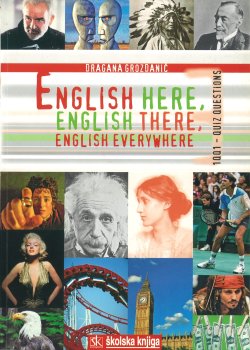
Menu
About the book
Introduction - raising intercultural awareness in a language classroom
The initiative for writing this book
Ordering the material - sorting through the richness of cultural experience
Who is this book for?
What are the strenghts of this book?
Intercultural topics – quizzes in the classroom – let's do the quizzes
How did you feel while doing the quizzes?
Recommended activities for using the quizzes
Each question can be used as the starting point for numerous speaking and/or writing activities
Let me know what you think - In the hands of motivated and creative teachers these 1QQ1 questions can be used in 1001 different ways
Published by Školska knjiga, Zagreb, Croatia, 2005
Copies are available through the publisher’s website: www.skolskaknjiga.hr or www.dominovic.hr, the online bookshop
English here, English there, English everywhere – 1QQ1 quiz questions is the synthesis of language and culture. It raises intercultural awareness (in a language classroom) by connecting the English speaking world and the English language with the learner’s world and his/her own language. Hidden in the very title is the reference to some intercultural topics, that is to the song Here, There and Everywhere, written by Paul McCartney and performed by The Beatles as well as to the famous children's song Old McDonald had a farm. Challenging multiple choice questions - covering history, geography, literature, sport, music, film, customs and traditions, holidays and celebration, proverbs and idioms, current topics, everyday life, famous people, places, events and so on - will motivate students and help them learn in an enjoyable way. There are 100 quizzes in the book. Each quiz consists of 10 quiz questions. The questions range from past history to the present day. Each question (1QQ1 quiz questions) can be the starting point for numerous speaking and writing activities which lead towards shared understanding. In the hands of motivated and creative teachers these 1QQ1 quiz questions can be used in 1001 different ways.
The initiative for writing this book came from my students, although I myself always felt the need for a good book about the culture and civilization of the English-speaking world, which would be both informative and fun, as well as challenging enough to incite students' interest in intercultural topics.
Every year English language competitions take place in my country, Croatia. Up until a few years ago the test questions were based mainly on vocabulary, grammar, reading and listening comprehension, but besides knowledge of the English language there were always some questions dealing with the culture and civilization of the English speaking word (The USA, the UK; Ireland, Canada, Australia, New Zealand). Some, but not all these facts were covered by the school curriculum. General knowledge of certain facts is a must, but my students always found it difficult when they were preparing for such competitions because at the age of 14 they were too young to distinguish important facts from less important ones. In order to make it easier for them I tried to summarize the important information in the form of questions. The question / answer format really worked and my students had great fun while learning. The approach has proved to be both informative and fun.. Students remember all these facts much more easily when they are presented in small chunks and in an interesting way.
Besides, I myself was always interested in the ways of raising intercultural awareness in a language classroom: How to teach culture (as an essential part of foreign language learning)? Where to find adequate teaching materials? To what extent are we the same / different? What are the possibilities of sharing and understanding? What are the possibilities of accepting differences and creating the basis for tolerance and peaceful coexistence among different cultures? Can foreign language learning improve potential for intercultural understanding, tolerance, peaceful co-existence?
The need to make it easier for my students was accompanied by my own thinking about teaching culture. That was the seed which resulted in my blossoming book English here, English there, English everwhere, 1QQ1 quiz questions.
The seed was there, the wish to plant/develop it into the rich teaching materials was eager, but then I was faced with numerous problems of organizing the material. Of course, it is impossible to include all the relevant facts. The choices are truly inexaustible. There are always difficulties when we try to impose some kind of order upon disordered and almost unlimited material. I will admit that at first I tried grouping the topics, but soon gave up the idea. It is not possible to impose order upon real life, as it is reflected in my randomly selected questions in each of 100 quizzes. Sorting through the richness of cultural experience opens almost infinite possibilities for creating such a book. This is only one among many. One cannot hope to give an exhaustive account of such a rich area. Besides, there are always new things. It is a neverending, open process. Every selection implies omission, but I find the present choice of materials to be, if not the best, then at least very helpful. I can only hope that I have included lots of relevant topics which students and teachers all over the world can benefit from. These questions will serve them as a guidepost. It is up to them to continue discovering for themselves later on.
In Quizzes 90 – 100 I partially succeeded in my otherwise abandoned attempt to group the topics. The questions in Quizzes 90-100 are ordered as follows: 1 history, 2 geography, 3 literature, 4 sport, 5 music, 6 film, 7 proverbs, 8 holidays, customs and traditions, 9 famous people and events, and 10 various topics.
This book is both for young people and adults, that is for anyone interested in the English language and general background knowledge of the English-speaking world. It is also for those who would like to have fun by testing thier knowledge and learning English at the same time, for curious kids who want to know more, for students who are preparing for school-leaving exams; for individual study, work in pairs, work in groups, at school and at home; for primary and secondary school teachers who can use the quiz questions in their regular lessons (warm-ups, follow-up activities, special topics for class work) and extracurricular activities; for private language school students and teachers, since it is the book that can accompany any course book. It can also be used by parents who want to 'compete' with their own children and teach them in a funny way. Not only can parents teach their children, children can also teach their parents as well. For example, while parents know more about the Beatles, their children can tell them everything about Justin Bieber or some famous teen pop stars the new generations listen to.
As the author, I consider the strenghts of this book to be many. Considering my students' and colleagues' reaction to the book, I hope I am not mistaken. As they say, the book is intriguing, challenging and successfully meets the demands of students.They can learn about the English speaking word's culture in an enjoyable way and connect the English speaking world and the English language with their own country and language. The book is informative and fun, so the children learn while they play. It also provides extra motivation for learning English (language in context), so students can improve their English in an amusing way. The book offers possibilities for a cross curricular approach. It can serve as a guidepost for future discoveries in the quest for knowledge and as the beacon of light in the sea of information on intercultural topics. The book also opens numerous possibilities for individual / pair / group project work in the classroom. I hope the book is clearly organised and easy to use. The language is simple, illustrations are attractive and the same topics can be successfully adapted to different age groups. The teacher is the one who decides what and how.
I. Have a look at the sample Quiz 11 from the book.
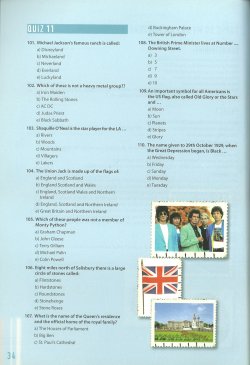
After scanning/ going over the questions, think about the following:
What are the fields of your interest: history, music, geography, sport…?
Which question topic(s) are you familiar with?
Which question topic(s) you know nothing about?
Which question topic(s) incite(s) your interest?
What would you like to investigate in more detail?
Which question(s) do you consider easy / difficult / intriguing / confusing / amusing…?
How do you like the illustrations?
Can they be of help to you in giving answers to some questions?
Are you ready for doing the quizzes? I hope you are. Let's do the first one together!
II. Quiz one
History
1 In the 1760’s the American colonists began objecting to British taxes, saying: ‘No taxation without… '
- liberation
- new generation
- communication
- representation
- cooperation
Geography
2 Which country are the words shamrock, Guinness and green associated with?
- Wales
- England
- Scotland
- Ireland
- Canada
Literature
3 In The Raven, the best-known poem by Edgar Alan Poe, the bird repeats this answer:
- Never say never
- Forever yours
- Nevermore
- More and more
- It’s now or never
Sport
4 Shaquille O’Neal was the star player for the LA…
- Rivers
- Woods
- Mountains
- Villagers
- Lakers
Music
5 Where were the Beatles from?
- London
- Dover
- Liverpool
- Oxford
- Cambridge
Film
6 Which of these actors is the wrong match for the film?
- Mel Gibson – Mad Max
- Tom Cruise – The Godfather
- Tom Hanks – Forest Gump
- Bruce Willis – Die Hard
- Richard Gere – An Officer and a Gentleman
Customs and traditions
7 Hongi is a Maori greeting in which people:
- wink and bow
- kneel for a few seconds
- stamp their feet
- rub noses
- shake both hands
Holidays and celebrations
8 The Welsh celebrate their patron saint’s day, St… Day, on 1st March
- Patrick’s
- David’s
- Edward’s
- Henry’s
- Peter’s
Proverbs
9 Complete the saying: ‘Don’t put all your… '
- …pots on the table
- …cakes on the plate
- …eggs in one basket
- …money in the bank
- …pencils in one box
Idioms and sayings
10 When someone buys something without properly examining it first, the English say they have bought ‘a… in a poke.’
- rat
- mouse
- cat
- dog
- pig
Answers:
1 d) representation, 2 d) Ireland, 3 c) Nevermore, 4.e) Lakers, 5.c) Liverpool, 6.b) Tom Cruise – The Godfather, 7 d) rub noses, 8 b) David’s, 9 c) eggs in one basket, 10 e) pig Well done!!! Congratulations!
III) Quiz two
Quiz questions can be grouped differently: the easy ones, difficult, amusing, confusing, challenging, informative in itself, and so on… Therefore, have another try!
Famous people
Samuel Langhorne Clemens wrote under the penname of:
- James Joyce
- Mark Twain
- William Shakespeare
- William Faulkner
- Aldous Huxley
Famous places
The high rock cliff in the US state of South Dakota famous for the carved heads of four US presidents is called Mount
- Rashomon
- Rushmore
- Rushdie
- Rumours
- Rust Belt
Famous events
In the second half of the 18th century a group of Americans threw large boxes of tea into the sea to protest the British tax on tea, an event known as The Boston…
- Tea Port
- Tea Pot
- Tea Party
- Tea Box
- Tax Tea
Everyday life
What can you do at Barclay's?
- Buy expensive clothes
- Buy second-hand clothes
- Have a traditional English breakfast
- Go to college
- Change money
Easy
For Halloween special lanterns are made from:
- watermelons
- oranges
- pumpkins
- coconuts
- pineapples
Difficult
The Jarrow March was a protest against:
- slavery
- unemployment
- Tudor rule
- alcohol consumption
- Oliver Cromwell
Tricky / Confusing
Native Americans hold festivals called:
- bow-wows
- pow-wows
- dow-wows
- pow-bows
- bow-pows
Amusing / Fun
Bill Clinton’s autobiography is etitled:
- My Africa
- My Life
- My Hillary
- My America
- My Monica
Interesting
What does ‘she sell by the sea shore’ in the famous tongue twister?
- seashells
- six saucers
- bracelets
- little dolphins
- candy floss
Informative in itself
Burns Night is celebrated in Scotland every year on 25th January. This marks the birthday of the famous Scottish poet… Burns
- George
- John
- Robert
- Philip
- William
With some unusual associations
Which of these types of music and dances is also the surname of a Charles Dickens character?
- Reggae
- Rock
- Charleston
- Jazz
- Twist
Answers: This is the opportunity to investigate and find the answers by yourself. Ask your peers/ parents/ teachers. Search the Internet, look in some history books, tourist guides, encyclopaedias and so on… or write to the author of the book for help in case you can't find the correct answer to any of the questions. - :)
Of course, the materials produced and piloted in our own environments could be used more productively within a wider international network, which will give us the possibility to assess our own approaches to intercultural topics as well as the opportunity to discuss intercultural issues with colleagues from different environments. Try to think about these questions and discuss them with your colleagues. You can also send me an e-mail. I would be glad to hear from you.
- How did you feel while doing the quizzes?
- Are you going to use any of these ideas in the classroom?
- How would you use the quizzes in the classroom?
- What do you think of introducing ICC in the language classroom by means of quiz questions?
- Would this approach help improve your students’ ICC and to what extent?
- Children can be grouped into pairs, but they can also be divided into two or more groups. Each pair/group is given the same Quiz (10 questions). The winner is the pair/group with the most correct answers (a time limit is set).
This can also be done individually. Each child is given the same Quiz.
- Children can be divided into groups and given a different Quiz (10 questions). The groups compete, such that each group alternately reads questions from its Quiz to its opponents. The winner is the group with most correct answers.
This can be also done in pairs, one child plays against another.
Children can also be given more than one test., but the time limit is very important.
- Try your luck. Choose your own Quiz by picking a number of the Quiz from the book and compete with your peers.
- Play a Jeopardy game. Choose three to five categories of answers. Or you can take any of the quiz keys. Put the Jeopardy game board on a big piece of paper and list the point values. Choose the teams and the team representative, who must confer with the team before asking the questions (giving the answer!), but is the only one who can give the answer. Choose the person who is respponsible for keeping score (adding and/or subtracting the points). Just to remind you, it is important to give an appropriate question to a certain answer. For example, if the answer is Abraham Lincoln, a correst question (one among many of them) would be 'Who abolished slavery?'
- You can group questions by topics and then have a history competition on Monday, a famous people competition on Tuesday, a geography competition on Wednesday, and so on. If having a competition every day seems like too much for you, then try a weekly or monthly competition.
- You can use the cover of the book / or pictures inside the book for ' Tell me something about it ' game. You can also play Make 5 questions / Write down 3 sentences / Describe in less than 10 sentences/ Compare your sentences, put them together and make a poster/ Investigate, collect all possible information from different sources and present it to the class in less than 10 minutes… and so on
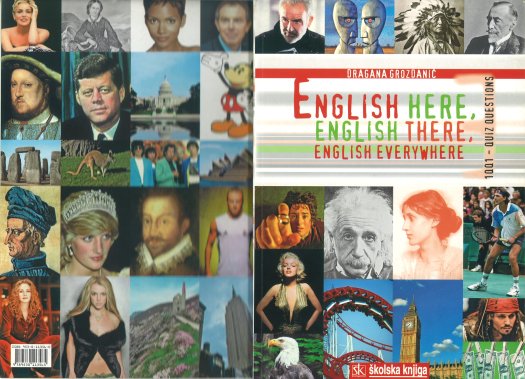
- Search the book and create your own quiz (10 questions). My students really like this activity. It is very creative. Students can express their own interest in certain topics. A student chooses ten questions from the book and copies them onto a piece of paper. He or she gives the quiz to the partner. The partner / the opponent in a game does the same. Afterwards, they check the answers and find who is better. To make it more interesting, students can copy eight or nine questions from the book, adding one or two quiz questions of their own, thus being creative and expanding the scope of the book.
Example: the quiz question number 333 (from the Quiz 34 on the left side of the book) is a trigger / a starting point for some speaking and writing activities ( Topic 34, on the right side of the book)
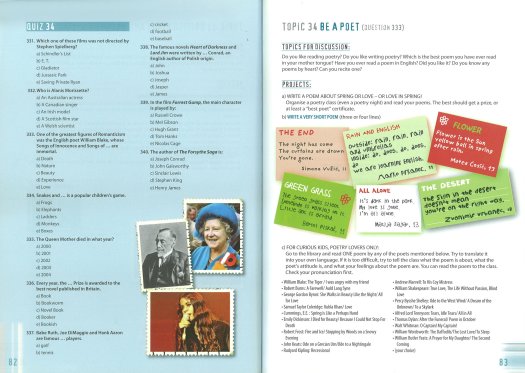
Each question can be used as the starting point for numerous speaking and/or writing activities which take into account the learner's world. Reading and understanding can be also included after the task is completed. The aim of the follow-up section comprising 100 topics is to encourage active use of language while learning about intercultural topics, including personalization, project work, work in pairs / groups, learning by doing, expressing opinions, giving advice, discussions, debates, doing research, sorting notes and material, freedom to choose / select / omit, creativity, comparison, a sense of achievement, recognition of progress, writing essays and dialogues, making a group wall display or a class magazine and many other things.
Here is another example of my students' projects based on history / famous people quiz questions number 544, 549. You can see how one of my students, who was 13 years old then, responded to the given task.
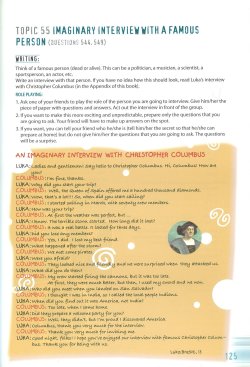
It is not an easy task to make a review of one's own book, not at all, especially the part when you do not just state the facts, but express your own belief that your book is really something special, from which many students and teachers will benefit greatly. Therefore, if you can, get hold of a copy, or based on what you have just read and the quizzes you did, let me know what you think.Your opinion on my work would be greatly appreciated.

Please check the British Life, Language and Culture course at Pilgrims website.
Please check the Methodology and Language for Secondary Teachers course at Pilgrims website.


|